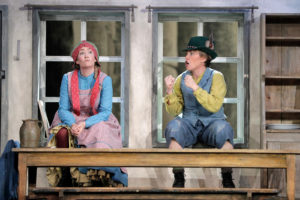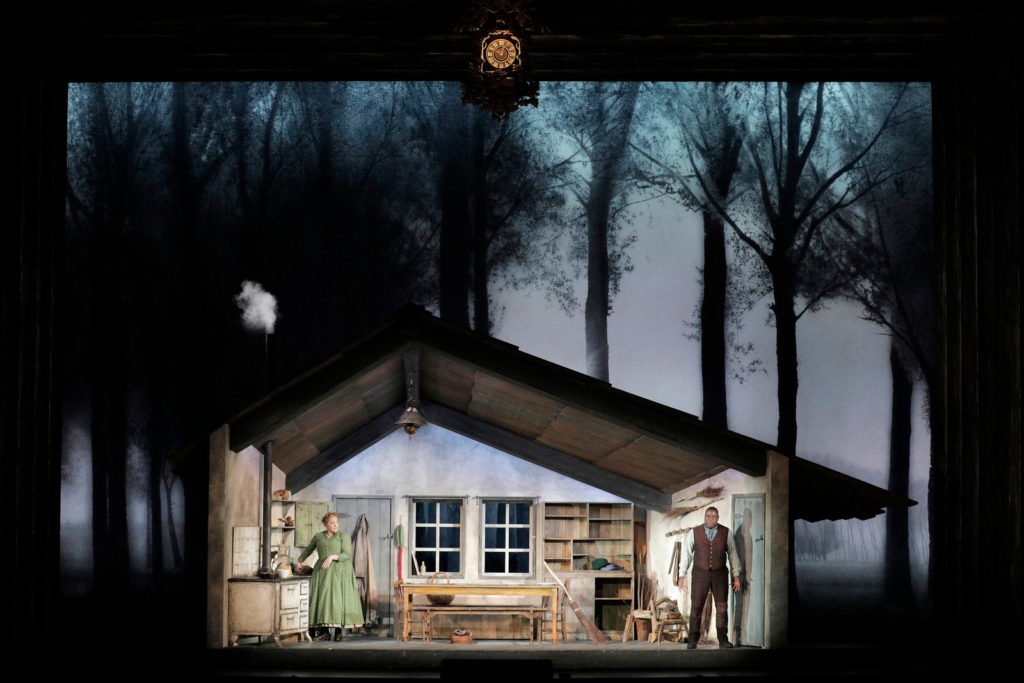
San Francisco Opera 2019-20 Review: Hansel and Gretel
Sasha Cooke & Heidi Stober Shine In Disney-fied Take on Classic Tale
By Lois Silverstein(Credit: Cory Weaver/San Francisco Opera)
Humperdinck’s “Hansel and Gretel” opened at the San Francisco War Memorial Opera House to round out the fall season repertoire.
Composed in the 1890s, Humperdinck based the opera on Grimm Brothers’ fairy tale, hinting at some of the darker ideas resplendent in the original tale. But alas, none of that seems to have permeated the modern readings of this work, cheery as its music might often be.
Now it comes to us scaffolded by user-friendly elements, most of its darker currents absent. Antony McDonald set the whole in a Heidi-esque landscape and populated the forest with familiar fairy tale icons who domesticate any tone of real danger. At this point, it is fair to wonder whether too much Disney has too effectively replaced the “once upon a time” we went to for our imagination-fix. The tone remained not simply free of danger, but pale, however deft the performance and the direction. Even the wicked witch gets his comeuppance before shivers of horror run down the spine.
Carrying the Show
Hansel and Gretel themselves, sung by mezzo-soprano Sasha Cooke and soprano Heidi Stober, more than carried the show. Each sang in festive holiday offering, and together they were more than double. Cooke sang Hansel with beauty, finesse and ease. Her voice soared over the orchestra and beyond, her tone remaining rich and caressing all the while she moved with ease, carrying off the necessary stage business of a small boy with aplomb. Child and competent adult she stayed throughout, a task not as easy as it seems. In her we found the conventional boy child who sleeps too late and doesn’t comb his hair but rises to be the protective brother who shouts at the stars.
Stober was an adorable Gretel. She bounced and leaped singing with merriment and gusto, playing a perfect companion to the brother she attended. Together, the pair illustrated just what has made the opera a favorite since its composition and first performance in 1896.
The other characters carried their weight overall, filling in the array of supports. Mezzo-Soprano Michaela Martens and Bass-Baritone Alfred Walker, as the parents, sang with enthusiasm, expressing a full range of thoughts and feelings that colored the family scene.
Other fairy tale characters appeared and disappeared in the woods. Rapunzel, Red Riding Hood, Snow White, and then The Dew Fairy were interpreted by Natalie Image, with the Sandman played by Ashley Dixon, and Will O’ the Wisp represented by Chiharu Shibata. Each scooted among the trees and assured that magic would thwart any danger that might rise. Happily, none did.
Tenor Robert Brubaker appeared as the witch. Dressed in skirt, apron and blouse, Brubaker cajoled and mimicked the good and bad witch mother with mincing manner. When he moved into a “quasi-strip-tease,” things went on an aesthetic slide. A witch who could do more than “simply” eat up little children? His submersion into the cauldron was a grotesque moment that we cheered. Ding Dong the witch is dead. Good riddance. Was it an effective piece of theater? We leave it to the audience to decide.

Credit: Cory Weaver/San Francisco Opera
A Pale World Colored By a Vibrant Ensemble
The Swiss-German hillside coated with scrim, allowed peeks into snippets of family scenes at the kitchen table, particularly during the Overture. A palette of light shades shifted to indicate time passing as well as mood and event. The cuckoo clock’s hands raced, but didn’t really advance any action significantly. As in the production overall, energy was spent, paint spilled, but nothing much happened as a result.
The woods remained inhabited but only with remembrance of things past. We had no connectors to what had before elicited charm or even its echo. It was like a walk-through rather than the real thing. Even the Gingerbread House, complete with cherry on top and protruding knife that took centerstage in the last act, did not look good enough to eat!
The key to the whole production remained with the Orchestra, under the baton of Christopher Franklin, an American conductor based in Italy. A large, “Wagnerian”-style orchestra with its multiple bands of strings, rows of brass, and winds, gave the appeal the music has long enjoyed.
The opening “Evening Prayer,” repeated in motif and harmonic bands throughout the first Act and in places in the Third, and the kick-your-feet up dance of the children all have taken their place in the musical lexicon. Franklin’s orchestral interpretations gave them their due. While the audience savored their presence and familiarity, the over-ripe presentation sometimes submerged the singers.
Thanks to the English translation in which the libretto was sung, and the backup of the subtitles, and, of course childhood familiarity, ensured that the audience never missed a textual beat. That said, contrast and extended support rather than dominance would have made a sweeter treat.
All in all, “Hansel and Gretel” decked the halls with a festive if not a somewhat worn-out take on a timeless tale. The singers were undeniably the source of this merry cheer, buoying the music to its vibrant heights.


